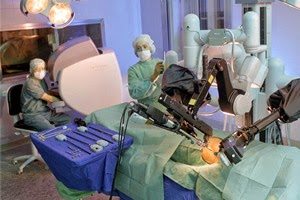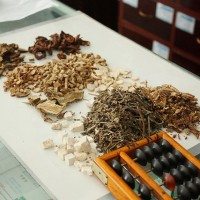
An acupuncturist and acupuncture anesthetist perform robotically-assisted acupuncture on a patient who has been feeling kind of tired lately
Developed over many thousands of years (or maybe a little less), what has come to be known as traditional Chinese acupuncture has proven capable of curing or at least ameliorating the symptoms of a variety of medical conditions. But one of its greatest strengths, the intimate connection between the practitioner and the acupuncture needle, is also one of its most significant weaknesses. Taking advantage of the robotic technology being used by surgeons to perform an increasing number of minimally-invasive procedures, cutting edge acupuncture providers are now able to provide relief for patients that were once felt to be either poor candidates or had failed to improve despite treatments with traditional acupuncture by hand.
The healing art of acupuncture may have deep roots in an ancient Eastern culture, but the modern technology now being used to augment it is pure Western medicine. The da Vinci Surgical System, a state of the art robotic technology, features a 3D high-definition magnification system and instruments able to maneuver with far greater precision than the human wrist and fingers. This is allowing specially trained acupuncturists to both locate and successfully target hard to reach acupuncture points, such as those on the eye, scrotum, and anal verge. This expands the number of conditions amenable to acupuncture to everything except space herpes.
“It’s obvious to me that this is an improvement, a paradigm shift if you will. It’s a leap forward in our ability to take care of our patients,” da Vinci certified acupuncturist Mort Fishman explained. “It really comes down to the bottom line. If someone in my family needed acupuncture, would I want that provider to be trained in robotics? Yes, I would.”
The improved vision and manual dexterity enjoyed by providers using the da Vinci system has allowed acupuncture to catch up to other alternative medical fields, some of which have been incorporating modern technology into their protocols for years. Chiropractors, practitioners who treat a variety of musculoskeletal conditions and also asthma for some reason, have historically been quick to adopt the latest high tech electronic devices, primarily in order to facilitate the location of abnormalities in the spine called subluxations. Once found, these silent killers can be removed using traditional hands-on techniques or with advanced space age technology. Some experts have even mastered the combination of manual and technology-based treatments.
Fishman, who is a pioneer in robotically-assisted minimally-invasive acupuncture fertility treatments, is already looking to the future. He envisions a day when even this groundbreaking technology is considered to old-fashioned. “As science progresses, and we continue to scale down robot technology and improve treatment algorithms, the physical act of acupuncture will be taken completely out of the hands of the practitioner. The human mind will be set free, allowing full mental focus on diagnosis.”

